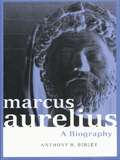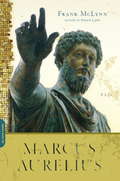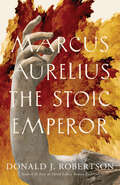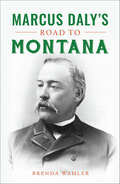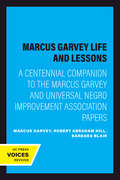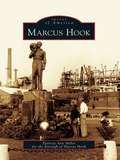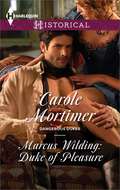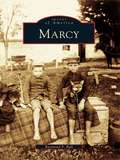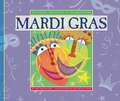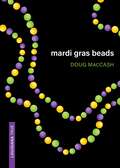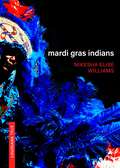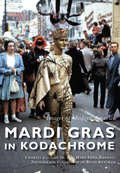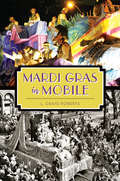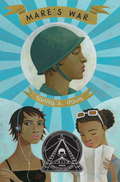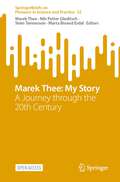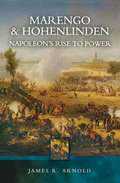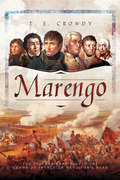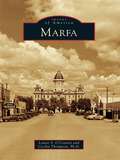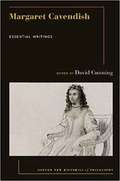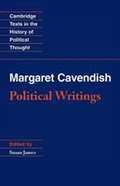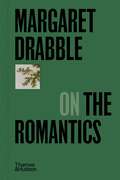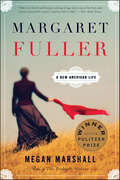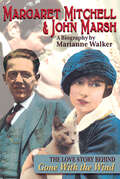- Table View
- List View
Marcus Aurelius: A Biography (Roman Imperial Biographies)
by Anthony R BirleyMarcus Aurelius, the philosopher-emperor who ruled the Roman Empire between AD 161 and 180, is one of the best recorded individuals from antiquity. Even his face became more than usually familiar: the imperial coinage displayed his portrait for over 40 years, from the clean-shaven young heir of Antonius to the war-weary, heavily bearded ruler who died at his post in his late fifties.His correspondence with his tutor Fronto, and even more the private notebook he kept for his last ten years, the Meditations, provides a unique series of vivid and revealing glimpses into the character and peoccupations of this emporer who spent many years in terrible wars against northern tribes.In this accessible and scholarly study, Professor Birley paints a portrait of an emporer who was human and just - an embodiment of the pagan virtues of Rome.
Marcus Aurelius: A Life
by Frank MclynnMarcus Aurelius (121-180 AD) is one of the great figures of antiquity whose life and words still speak to us today. His Meditations remains one of the most widely read books from the classical world, and his life represents the fulfillment of Plato’s famous dictum that mankind will prosper only when philosophers are rulers. Based on all available original sources, Marcus Aurelius is the definitive biography to date of this monumental historical figure.
Marcus Aurelius: The Stoic Emperor (Ancient Lives)
by Donald J. RobertsonExperience the world of Roman emperor Marcus Aurelius and the tremendous challenges he faced and overcame with the help of Stoic philosophy This novel biography brings Marcus Aurelius (121–180 CE) to life for a new generation of readers by exploring the emperor&’s fascinating psychological journey. Donald J. Robertson examines Marcus&’s relationships with key figures in his life, such as his mother, Domitia Lucilla, and the emperor Hadrian, as well as his Stoic tutors. He draws extensively on Marcus&’s own Meditations and correspondence, and he examines the emperor&’s actions as detailed in the Augustan History and other ancient texts. Marcus Aurelius struggled to reconcile his philosophy and moral values with the political pressures he faced as emperor at the height of Roman power. Robertson examines Marcus&’s attitude toward slavery and the moral dilemma posed by capturing enemies in warfare; his attitude toward women; the role of Stoicism in shaping his response to the threat of civil war; the treatment of Christians under his rule; and the naming of his notorious son Commodus as his successor. Throughout, the Meditations is used to shed light on the mind of the emperor—his character, values, and motives—as Robertson skillfully weaves together Marcus&’s inner journey as a philosopher with the outer events of his life as a Roman emperor.
Marcus Daly's Road to Montana
by Brenda WahlerThe Making of a Copper King!Born in 1841 to tenant farmers, Marcus Daly came from ruralIreland to New York as a boy. Having learned the big city&’s harsh lessons, he traveled west to the gold and silver mining camps ofCalifornia, Nevada, Utah and Montana. Then, a spectacular discovery in the Anaconda mine him one of Montana&’s famed Copper Kings. Yet, his early life remained shrouded in myth. Famed for his machinations in state politics and shaping Butte into the &“Richest Hill on Earth,&” his path from farm boy to mining king has been overlooked. For the first time, author Brenda Wahler brings his secretive and formative early years to life.
Marcus Furius Camillus: The Life of Rome's Second Founder
by Marc HydenThis is the only modern biography of Marcus Furius Camillus currently available in English. Camillus served as a censor, was elected to six consular tribuneships, appointed dictator five times, and enjoyed four triumphs. He toppled mighty Veii, ejected the Senones from Rome following its sacking, and helped orchestrate a grand compromise between the patricians and plebeians. The Romans even considered him Rome’s second founder – a proud appellation for any Roman – and revered him for being an exemplar of Roman virtue. Interestingly, he never held the consulship. Plutarch stated that Camillus had avoided it on purpose, and for good reason. The office was often at the heart of controversy, given that patricians dominated it for most of Camillus’ life. The appointment of a dictator was an emergency measure taken only in the direst of situations and the fact that Camillus was repeatedly appointed speaks of a period when the young Republic was surrounded by enemies and still fighting for survival. Without Camillus’ efforts the city may never have fulfilled its great destiny. Marc Hyden sifts the fragmentary and contradictory sources and, while acknowledging that much legend and exaggeration quickly accrued around Camillus’ name, presents the story of this remarkable life as the ancient Romans knew it.
Marcus Garvey Life and Lessons: A Centennial Companion to the Marcus Garvey and Universal Negro Improvement Association Papers
by Marcus Garvey"I do not speak carelessly or recklessly but with a definite object of helping the people, especially those of my race, to know, to understand, and to realize themselves."—Marcus Garvey, Halifax, Nova Scotia, 1937A popular companion to the scholarly edition of The Marcus Garvey and Universal Negro Improvement Association Papers, this volume is a collection of autobiographical and philosophical works produced by Garvey in the period from his imprisonment in Atlanta to his death in London in 1940.
Marcus Hook
by Borough of Marcus Hook Patricia Ann MillerMarcus Hook is the northernmost city on the Delmarva Peninsula. Incorporated in 1892, Marcus Hook was originally named for a Native American chief and was once the haunt of English pirate Edward Teach (Blackbeard). It is now best known as the home of SunOil Refinery. Thanks to its location along the Delaware River, the town prospered as residents and businesses flocked to the area. Other large businesses located here include the former American Viscose and British Petroleum. Through vintage photographs, Marcus Hook commemorates the longstanding heritage of this small community and the growth of the Delaware River waterfront.
Marcus Wilding: Duke of Pleasure
by Carole MortimerIn this scintillating prequel novella to her Dangerous Dukes miniseries, USA TODAY bestselling historical author Carole Mortimer delivers a feast for the senses!England, 1815He's the most accomplished lover in England, and the finest tutor in pleasure that ever lived!Lady Julianna Armitage is on a mission:  - The goal: Discover passion and learn the true art of lovemaking, something she never experienced in her short, loveless marriage.  - The teacher: The devastatingly handsome Marcus Wilding, Duke of Worthing; the one man she could never have...until now.  - The outcome: Pure, decadent, indulgent satisfaction!Julianna is determined to maintain control, but as Marcus unleashes a sensual siege that awakens her every sense, it soon becomes clear that losing control can be the most delicious thing of all!Don't miss this shockingly seductive new series from legendary bestselling author Carole Mortimer:Dangerous DukesRakes about townZACHARY BLACK: DUKE OF DEBAUCHERYAvailable October 2014DARIAN HUNTER: DUKE OF DESIREAvailable November 2014
Marcy: Early Aviation History Of Oneida County, N. Y. (Images of America)
by Raymond F. BallMarcy is not a town but rather a township made up of several hamlets, Stittville being the largest. These hamlets originated with groups of various religions and nationalities, such as Welch, Methodist, and Baptist. The one thing they all had in common was their desire to survive and prosper. The answer was in farming and all the hard work that had to be done every day. In the late 1850s, everything changed when the railroad came to town. Travel outside the farm fences became easy and enjoyable. Residents could catch the train and, in only 20 minutes, be in Utica, a whole different world, with stores and merchandise unlike anything on the farm. Today the farming has all but gone, and Marcy is largely a bedroom community with a mixture of small shops, electricity and water distribution systems, and higher education institutions.
Mardi Gras (Holidays, Festivals, & Celebrations)
by Ann HeinrichsLet the good times roll! Colorful floats, shiny beads, and delicious king cakes herald the arrival of Mardi Gras. Kids discover the origins of Mardi Gras and learn about the food and activities associated with this famous festival.
Mardi Gras Beads (Louisiana True)
by Doug MacCashBeads are one of the great New Orleans symbols, as much a signifier of the city as a pot of scarlet crawfish or a jazzman’s trumpet. They are Louisiana’s version of the Hawaiian lei, strung around tourists’ and conventioneers’ necks to demonstrate enthusiasm for the city. The first in a new LSU Press series exploring facets of Louisiana’s iconic culture, Mardi Gras Beads delves into the history of this celebrated New Orleans artifact, explaining how Mardi Gras beads came to be in the first place and how they grew to have such an outsize presence in New Orleans celebrations.Beads are a big business based on valuelessness. Approximately 130 shipping containers, each filled with 40,000 pounds of Chinese-made beads and other baubles, arrive at New Orleans’s biggest Mardi Gras throw importer each Carnival season. Beads are an unnatural part of the natural landscape, persistently dangling from the trees along parade routes like Spanish moss. They clutter the doorknobs of the city, sway behind its rearview mirrors, test the load-bearing strength of its attic rafters, and clog its all-important rainwater removal system.Mardi Gras Beads traces the history of these parade trinkets from their origins before World War One through their ascent to the premier parade catchable by the Depression era. Veteran Mardi Gras reporter Doug MacCash explores the manufacture of Mardi Gras beads in places as far-flung as the Sudetenland, India, and Japan, and traces the shift away from glass beads to the modern, disposable plastic versions. Mardi Gras Beads concludes in the era of coronavirus, when parades (and therefore bead throwing) were temporarily suspended because of health concerns, and considers the future of biodegradable Mardi Gras beads in a city ever more threatened by the specter of climate change.
Mardi Gras Indians (Louisiana True)
by Nikesha WilliamsMardi Gras Indians explores how sacred and secular expressions of Carnival throughout the African diaspora came together in a gumbo-sized melting pot to birth one of the most unique traditions celebrating African culture, Indigenous peoples, and Black Americans. Williams ties together the fragments of the ancient traditions with the expressed experiences of the contemporary. From the sangamentos of the Kongolese and the calumets of the various tribes of the lower Mississippi River valley to one-on-one interviews with today’s Black masking tribe members, this book highlights the spirit of resistance and rebellion upon which this culture was built.
Mardi Gras in Kodachrome (Images of Modern America)
by Charles Cassady Jr. Mary Lynn Randall Ruth KetchamAmerica's greatest party and America's most colorful city, in all their shades, shimmer here in a never-before-published 1950-1960 collection of photographs taken at New Orleans's annual Mardi Gras. Photographer Ruth Ketcham chose the revolutionary Kodachrome slide film to capture Carnival, its walking and parading krewes, bystanders, and masquers. Kodachrome's fade-resistant images preserve a bygone 1950s era, not only of Mardi Gras but also of a bustling French Quarter, alive again with Regal Beer ("Red beans and rice / And Regal on ice"), Dixieland jazz clubs, the burlesque dancers and temptations of Bourbon Street, and the shopper's paradise that was Canal Street.
Mardi Gras in Mobile
by L. Craig RobertsMardi Gras in Mobile began its carnival celebration years before the city of New Orleans was founded. In the 1700s, mystic societies formed in Mobile, such as the Societe de Saint Louis, believed to be the first in the New World. These curious organizations brought old-world traditions as they held celebrations like parades and balls with themes like Scandinavian mythology and the dream of Pythagoras. Today, more than 800,000 people annually take in the sights, sounds and attractions of the celebration. Historian and preservationist L. Craig Roberts, through extensive research and interviews, explores the captivating and charismatic history of Mardi Gras in the Port City.
Mare's War
by Tanita S. DavisMeet Mare, a grandmother with flair and a fascinating past. <P><P>Octavia and Tali are dreading the road trip their parents are forcing them to take with their grandmother over the summer. After all, Mare isn’t your typical grandmother. She drives a red sports car, wears stiletto shoes, flippy wigs, and push-up bras, and insists that she’s too young to be called Grandma. <P><P> But somewhere on the road, Octavia and Tali discover there’s more to Mare than what you see. She was once a willful teenager who escaped her less-than-perfect life in the deep South and lied about her age to join the African American battalion of the Women’s Army Corps during World War II. <P><P>Told in alternating chapters, half of which follow Mare through her experiences as a WAC member and half of which follow Mare and her granddaughters on the road in the present day, this novel introduces a larger-than-life character who will stay with readers long after they finish reading.
Marek Thee: A Journey through the 20th Century (SpringerBriefs on Pioneers in Science and Practice #32)
by Nils Petter Gleditsch Marta Bivand Erdal Stein Tønnesson Marek TheeMarek Thee was a Jewish Polish journalist, scholar, and activist. This book tells his life from narrowly escaping death in the Holocaust to exile in Palestine, where he became attached to the Polish consular service. On his return to Poland in 1950, he worked for the Foreign Ministry and later for the Polish Institute for International Affairs. He served as Head of the Polish delegation to the International Control Commission in Indochina in the late 1950s. In 1968 he lost his job and his Polish citizenship in a nationalistic and antisemitic campaign. He was able to move to Norway where he worked for twenty years at the Peace Research Institute Oslo (PRIO), editing an international quarterly journal, Bulletin of Peace Proposals and doing research on the arms race. In retirement, he continued his research and writing at the Norwegian Human Rights Institute. The book vividly relates the drama of his life in Poland, Palestine, Indochina, and Norway.This is an open access book.
Marengo & Hohenlinden: Napoleon's Rise to Power
by James R. Arnold&“A good overview of the forces, their tactics, mistakes (and lies in official reports)&” of the two pivotal campaigns that cemented Napoleon&’s dictatorship (Paper Wars). In a tense, crowded thirty-three days in the autumn of 1799, Napoleon Bonaparte organized a coup and made himself dictator of France. Yet his position was precarious. He knew that France would accept his rule only if he gained military victories that brought peace. James Arnold, in this detailed and compelling account, describes the extraordinary campaigns that followed. At Marengo, Bonaparte defeated the Austrians and his fellow general Jean Moreau beat the combined Austrian and Bavarian armies at Hohenlinden. These twin campaigns proved decisive. Bonaparte&’s dictatorship was secure and his enemies across Europe were forced in a 15-year struggle to overthrow him.
Marengo: The Victory That Placed the Crown of France on Napoleon's Head
by Terry CrowdyOn 14 June 1800 Napoleon Bonaparte fought his first battle as French head of state at Marengo in northern Italy. Unexpectedly attacked, Napoleons army fought one of the most intense battles of the French Revolutionary Wars. Forced to retreat, and threatened with encirclement, Napoleon saved his reputation with a daring counterattack, snatching victory from the jaws of defeat. This battle consolidated Napoleons political position and placed the crown of France within his reach.Meticulously researched using memoirs, reports and regimental histories from both armies, Marengo casts new light on this crucial battle and reveals why Napoleon came so close to defeat and why the Austrians ultimately threw their victory away. With the most detailed account of the battle ever written, the author focuses on the leading personalities in the French and Austrian camps, describing the key events leading up to the battle, and the complex armistice negotiations which followed. For the first time, the author exposes the full story of Carlo Gioelli, the enigmatic Italian double agent who misled both armies in the prelude to battle.
Marfa
by Louise S. O'Connor Cecilia ThompsonIn the rugged High Chihuahua Desert of West Texas, Marfa lies in the northeast corner of Presidio County, 60 miles from the Mexico border. Originally established as a water stop for the Galveston, Harrisburg, and San Antonio Railroad in 1883, it soon became the county seat and heart of a thriving commercial center built around ranching. Marfa's Fort D. A. Russell, first known as Camp Albert and later Camp Marfa, has been home to numerous military units from the early 1900s through the end of World War II. This military presence, combined with the development of the famous Highland Hereford that propelled local cattle ranching to a nationally recognized level, provided the economic and social base for the community well into the 1950s. Marfa's proximity to Mexico contributes tremendously to a remarkable blend of cultures, and today the once remote frontier town has established itself as a sophisticated arts and cultural mecca.
Margaret Cavendish: Essential Writings (Oxford New Histories Of Philosophy)
by David CunningThe Seventeenth-Century philosopher, scientist, poet, playwright, and novelist Margaret Cavendish went to battle with the great thinkers of her time, and arguably got the better of them in many cases. She took a creative and systematic stand on the major questions of philosophy of mind, epistemology, metaphysics, and political philosophy. She argued that human beings and all other members of the created universe are purely material creatures, and she held that there are many other ways in which creatures are alike as well: for example, human beings, non-human animals, spiders, cells, and all other beings exhibit skill, wisdom, and activity, and so the universe of matter is not the largely dead and unimpressive region that most of her contemporaries thought it to be. Creatures instead are sophisticated and display a wide spectrum of intelligent activity, ranging from the highly conscious mentality that Descartes posited to be part and parcel of human thought, to embodied forms of cognition that is more common in non-human creatures but that guide a significant portion of human behavior as well. Cavendish then used her fictional work to further illustrate her views and arguments, and also to craft alternative fictional worlds in which the climate for women was very different than on Seventeenth-Century earth - a climate in which women could be taken seriously in the role of philosopher, writer, scientist, military general, and other roles. <P><P> This is the first volume to provide a cross-section of Cavendish's writings, views and arguments, along with introductory material. It excerpts the key portions of all her texts including annotated notes highlighting the interconnections between them. Including a general introduction by Cunning, the book will allow students to work toward a systematic picture of Cavendish's metaphysics, epistemology, and political philosophy (and including some of her non-philosophical work as well) and to see her in dialogue with philosophers who are part of the traditional canon.
Margaret Cavendish: Political Writings (Cambridge Texts in the History of Political Thought)
by Margaret Cavendish Susan JamesMargaret Cavendish, Duchess of Newcastle, published a wide variety of works including poems, plays, letters and treatises of natural philosophy, but her significance as a political writer has only recently been recognised. <P><P>This major contribution to the series of Cambridge Texts includes the first ever modern edition of her Divers Orations on English social and political life, together with a new student-friendly rendition of her imaginary voyage, A New World called the Blazing World. Susan James explains the allusions made in this classic text, and directs readers to the many intellectual debates with which Cavendish engages. Together these two works reveal the character and scope of Margaret Cavendish's political thought. She emerges as a singular and probing writer, who simultaneously upholds a conservative social and political order and destabilises it through her critical and unresolved observations about natural philosophy, scientific institutions, religion, and the relations between men and women.
Margaret Drabble on the Romantics (Pocket Perspectives)
by Margaret DrabbleA highly acclaimed novelist on the way in which the landscape has both influenced and been represented in British Romantic literature. Margaret Drabble on the Romantics presents an image of Britain as seen through the eyes of some of its most celebrated writers. Many of the Romantics, as well as their successors, are closely associated with particular landscapes—the Wordsworths with the Lake District, Walter Scott with the Scottish Borders, and the Bronte¨ sisters with West Yorkshire. Drabble deepens our understanding of this connection, unpacking the Romantics’ fascination with all varieties of rural landscape, from roaring seas to tranquil villages, while also exploring their writing’s subtler associations. Herself a literary luminary, Drabble illuminates how this love of place fashioned some of the Romantics’ greatest works. She considers the resonances of myth and legend, art and earlier literature that the Romantics found in places such as North Wales and Cornwall, and investigates how their writing has, in turn, shaped our visual attitudes, taste in landscape and relation to nature.
Margaret Fell, Letters, and the Making of Quakerism (Material Readings in Early Modern Culture)
by Marjon AmesIntensely persecuted during the English Interregnum, early Quakers left a detailed record of the suffering they endured for their faith. Margaret Fell, Letters, and the Making of Quakerism is the first book to connect the suffering experience with the communication network that drew the faithful together to create a new religious community. This study explores the ways in which early Quaker leaders, particularly Margaret Fell, helped shape a stable organization that allowed for the transition from movement to church to occur. Fell’s role was essential to this process because she developed and maintained the epistolary exchange that was the basis of the early religious community. Her efforts allowed for others to travel and spread the faith while she served as nucleus of the community’s communication network by determining how and where to share news. Memory of the early years of Quakerism were based on the letters Fell preserved. Marjon Ames analyzes not only how Fell’s efforts shaped the inchoate faith, but also how subsequent generations memorialized their founding members.
Margaret Fuller: A New American Life
by Megan MarshallWinner of the Pulitzer Prize for BiographyFrom an early age, Margaret Fuller provoked and dazzled New England’s intellectual elite. Her famous Conversations changed women’s sense of how they could think and live; her editorship of the Transcendentalist literary journal the Dial shaped American Romanticism. Now, Megan Marshall, whose acclaimed The Peabody Sisters “discovered” three fascinating women, has done it again: no biography of Fuller has made her ideas so alive or her life so moving. Marshall tells the story of how Fuller, tired of Boston, accepted Horace Greeley’s offer to be the New-York Tribune’s front-page columnist. The move unleashed a crusading concern for the urban poor and the plight of prostitutes, and a late-in-life hunger for passionate experience. In Italy as a foreign correspondent, Fuller took a secret lover, a young officer in the Roman Guard; she wrote dispatches on the brutal 1849 Siege of Rome; and she gave birth to a son. Yet, when all three died in a shipwreck off Fire Island shortly after Fuller’s fortieth birthday, the sense and passion of her life’s work were eclipsed by tragedy and scandal. Marshall’s inspired account brings an American heroine back to indelible life.
Margaret Mitchell & John Marsh: The Love Story Behind Gone With the Wind
by Marianne WalkerBased on almost 200 previously unpublished letters and extensive interviews with their closest associates, Walker's biography of Margaret Mitchell and her husband, John Marsh, offers a new look into a devoted marriage and fascinating partnership that ultimately created a Pulitzer Prize–winning novel. This edition of Walker's biography celebrates the seventy-fifth anniversary of the publication of Gone With the Wind in 1936.In lively extracts from their letters to family and friends, John and Margaret, who also went by Peggy, describe the stormy years of their courtship, their bohemian lifestyle as a young married couple, the arduous but fulfilling years when Peggy was writing her famous novel, the thrill of its acceptance for publication and its literary success, and the excitement of the making of the movie. In telling the private side of this twenty-four-year marriage, author Marianne Walker reveals a long-suspected truth: Gone With the Wind might have never been written were it not for John Marsh. He was Peggy's best friend and constant champion, and he became her editor, proofreader, researcher, business manager, and the inspiration and motivation behind her writing. At every point, including the turbulent years of Mitchell's first marriage to Red Upshaw, it was John who provided the intellectual stimulation, emotional support, and editorial insights that allowed Peggy to channel her talents into the creation of her astounding Civil War epic. From years of meticulous research, Marianne Walker details the intimate and moving love story between a husband and wife, and between a writer and her editor.
